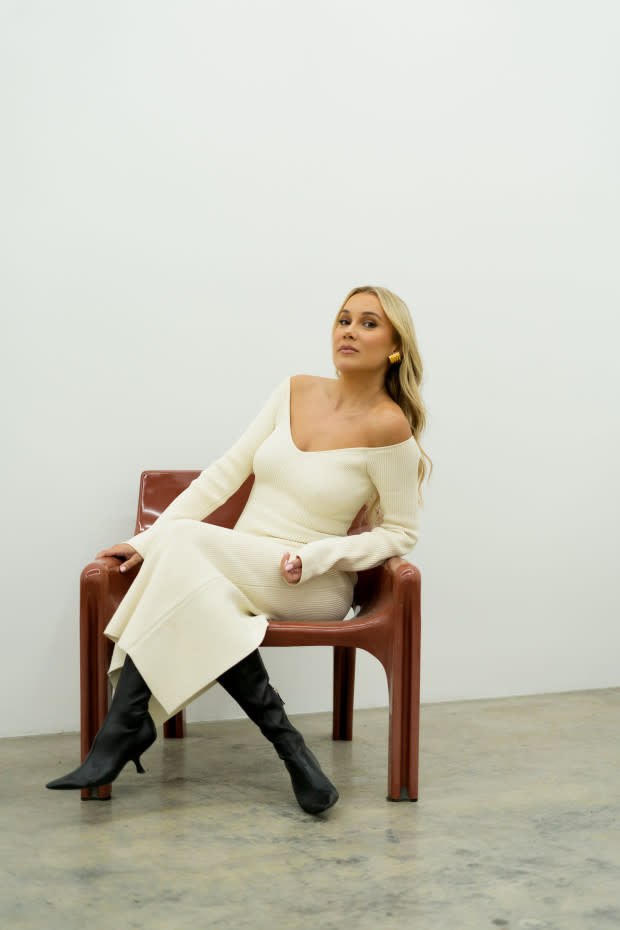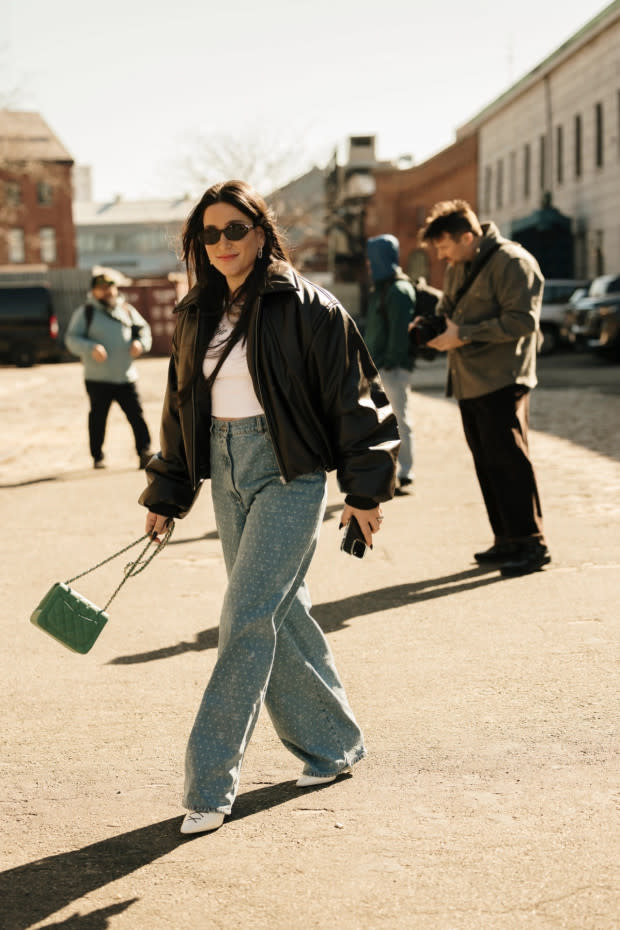How Do You Become a Fashion Sourcer?
In 2018, Gab Waller was tasked with doing the impossible: tracking down a tremendously rare, Phoebe Philo-era Céline coat that hadn't been in stores in years for a glamorous, high-profile client 7,500 miles away. It was a good thing that Waller, then living in Sydney, was up for the challenge, having just left a plum job within the Australian government to launch her own business in personal shopping and fashion sourcing. This could be her big break.
It was, as it turned out.
Waller had just spoken with a boutique in Denmark that had the coat only a week earlier, and quickly secured it for the celebrity client in question, Rosie Huntington-Whiteley, who publicly thanked Waller on Instagram for her 19 million followers to see. The rest, as they say, was history.
Today, Waller leads offices in both Australia and Los Angeles, where she's now based, with a global team of sourcing assistants throughout capitals like Paris, London, Hong Kong and Dubai. The supermodel set is still chief among Waller's clientele, but she's built her company upon the belief that each and every luxury shopper should have their own Huntington-Whiteley moment, be they celebrities or not.
As her business has grown, so has the demand for finding the unfindable. There's no such thing as "sold out," according to Waller.
"Time is a huge factor," she says. "I know my clientele. They're all shopping the retailers we know and love, and as soon as they see the words 'out of stock,' all they have to do is send me one quick DM, and everything else is handled."
Waller's job as an expert fashion sourcer is still relatively new to the industry landscape. It's so new, in fact, that there's no clear blueprint for prospective sourcers on how to break into the business. So, we spoke with a selection of fashion's top sourcers — like Waller, Jennifer Nisan, Mary Higham and Erica Wright, founder and CEO of sourcing platform Sourcewhere — to help identify how to make it in luxury sourcing, and what the job really entails.
What's the difference between sourcing and personal shopping?
To date, Waller has built an estimated 90% of her business on what she calls "global fashion sourcing," in which a client will submit a request for a specific, often exclusive item. Sometimes, they will have already identified the brand and even the season of which said item was a part; other times, they will have simply seen someone walking down the street wearing something fabulous, and enlist Waller to find it. (She does, somehow.)
The remaining 10% of her business can be better described as personal shopping, in which Waller generates outbound requests among her clientele. On her Instagram, she'll display various items she can source immediately as a way to gain interest. In June, for example, she posted an image of a rare "The Little Mermaid"-inspired Capucines handbag from Louis Vuitton's Resort 2024 collection, complete with more than 5,000 sequins, crystals and metallic and glass beads, created through over 30 hours of labor. The comment section made it clear that it wouldn't take long for Waller to sell the piece. (This differs from Waller's sourcing services, for which a client would seek out her expertise to locate the bag in the first place.)

Photo: Courtesy of Gab Waller
How can one break into sourcing?
As founder and CEO of Front Row Live, a highly sought-after luxury shopping concierge company, Jennifer Nisan owes her big break to a single Gucci bag in 2019. After posting the limited-edition accessory on Instagram, Nisan received a fortuitous phone call from a friend asking where she could find it, to purchase for herself.
"I faked it until I made it," remembers Nisan, who's based in New York City. "I was like, 'I can get you the bag. Just send me your info.' I started calling every Gucci store in the country until I landed on one of these bags at a store in Atlanta."
A week later, Nisan received another phone call, this time from someone who had heard of Nisan's talents and wanted a rare Gucci bag of her own. When the pandemic hit a year later, Nisan became busier than ever: As stay-at-home mandates restricted individuals from shopping in-store, she became the person her clients would approach to help them shop without ever having to leave the house.
New York-based stylist and personal shopper Mary Higham found her way to sourcing from a similar path that seemed to stem from some innate talent.
"I've always had a knack for finding unique pieces, and slowly over time, I moved from having friends and family asking me to help them find pieces and referring me, to developing a network of over 300 women in the U.S. and a handful of international clients," she explains. "It's all about building trust with both your clients and with brands."
What does a sourcer's day-to-day look like?
Rest assured: No two days are the same, but the mornings are crucial.
Waller wakes up to a full inbox, with both personal requests from clients as well as updates from her global network of sourcing assistants who have worked in their respective time zones through the Los Angeles night. ("There's always someone online, which is fantastic.")
With her full team, Waller has been able to step back from the day-to-day grind and hand off the majority of sourcing, with various exceptions. "My pride and joy is finding items," she says. "I do so more for my own personal enjoyment now, and because it's such a passion of mine. I still love getting in there and finding the hidden gems."
View the original article to see embedded media.
Otherwise, Waller presides over the company holistically, and a significant component of that includes networking — maintaining and building her clientele via face-to-face lunches, dinners and bigger industry events. She also oversees the company's social media platforms, and for good reason: "We're a social media-based business. My content team manages TikTok; they have full creative control, and I love the ideas they're putting out. But Instagram is our main sales channel, so I'm very particular about what's posted there."
What are sourcers sourcing right now?
Fashion sourcing may be most closely associated with hyper-luxury shoppers eager to swoop up five-digit Hermès pieces, but the experts agree that it's more accessible than one might think. Take fragrances, a growing category in which Nisan is fielding more and more requests.
"I just did a fragrance for somebody yesterday," says Nisan. "She said, 'Hey, I'm too lazy to go to the store and pick out a fragrance. Can you just send me one, anything you think I would like?' People just want convenience. Everyone wants everything through the tap of a finger today."
Celine, old and new, is a common request. Shay Mitchell came to Nisan for help locating an extra-wide beach hat — the Triomphe Hat in Monogram Cotton, to be specific — just earlier this summer; Sofia Richie Grainge enlisted Waller to source an "Old Céline" dress that she went on to promote on her Instagram Story for her 10 million followers.
On Sourcewhere, the fashion sourcing app that allows shoppers to request luxury fashion products and be connected with sellers, recent high-traffic finds have included an Old Céline jumpsuit from the Spring 2015 collection, a pair of The Row's Igor trousers in beige and a rare sweater from a 2019 Miu Miu x Disney collaboration.
"We see a balance between present- and past-season items sourced, which is unique to our platform and, specifically, to sourcing," says Wright, Sourcewhere's founder and CEO. "We had a request in the U.K. for a rare red lantern bag from the Loewe x "Spirited Away" collection that was only available in Asia. One of the sourcers in our network matched to the request, and the client received it a week later."
Alaia, too, is trending: Nisan just scouted a pair of the house's sold-out studded ballerina flats for Copenhagen-based stylist Emili Sindlev, and is busy fielding growing requests for its fishnet shoulder bags.

Photo: Courtesy of Jennifer Nisan
How do sourcers build and scale their business?
With the role being service-based, relationships are key — both with one's clientele as with the folks helping to secure the merchandise in the first place.
Nisan credits the success of her business to the connections she's built with in-store employees: "It takes two to source — the sourcer and the source where you're sourcing from. If you're an associate and you're helping me get something I need for a client of mine, you're valuable to me, and I'm forever grateful to you."
How, exactly, does Nisan go about nurturing these relationships? Sometimes it's as simple as showing them your appreciation by checking in periodically or by respecting their time off when they're on vacation. When a store associate feels all take and no give, she says, it shows in the service you, as a sourcer, will receive — and that ultimately impacts the client's experience.
"I have associates who text me and they're like, 'Hey, this just came in. Do you want it before I offer it to anyone else?' Why would they do that? Because over time, we've built that relationship, and that's what makes my business thrive," she explains. "I'm always trying to communicate with the people I work with. We've established this great flow, and it works."
This is just as relevant from a client-communication standpoint, of course. Waller finds that as her business has scaled, she's set out to be more thoughtful about the personal relationships that have grown alongside it. And every client relationship looks different because, well, every client has different needs.
"There's no age limit on my clientele," says Waller. "I have girls who are 18, purchasing their first luxury handbag, right up to the 50-plus-year-old women I'm sourcing their entire summer wardrobes for. They all just love and appreciate fashion. I wouldn't even go as far to say luxury fashion, because I work with girls who are wanting to source Adidas Sambas sneakers or the trending Ugg boots — those aren't entirely considered luxury items, per se, but that's certainly a big part of my business." (Nisan, too, is riding the Samba wave: "Last week alone, I got about 25 requests for Adidas Sambas.")
And then there's the nitty-gritty backend of the business. How does one handle hundreds of packages coming in from all over the world at any given moment? Waller notes that she would be lost without the in-house processes and operations she learned throughout her days working in government.
"The job is not glamorous," says Higham. "Starting out, there's a great deal of hustle, of lugging too many shopping bags at sample sales, of creating extensive spreadsheets — and the shipping and accounting administration. It's a lot of hard work, so be prepared. Prepare for a growth period; developing a client list can take years."
